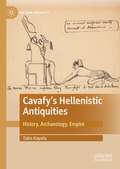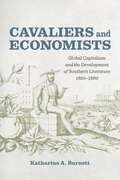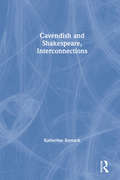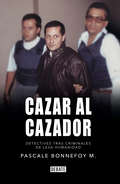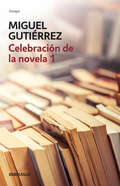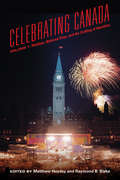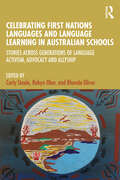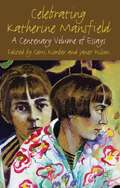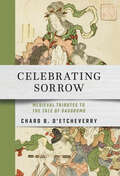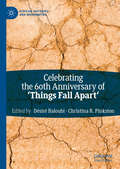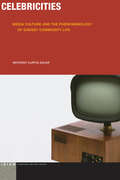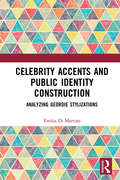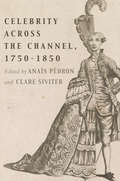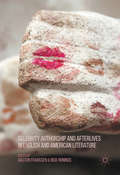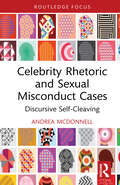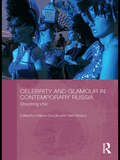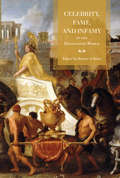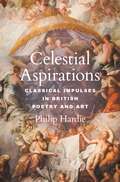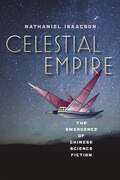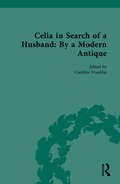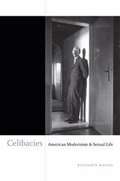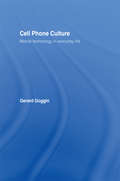- Table View
- List View
Cavafy's Hellenistic Antiquities: History, Archaeology, Empire (The New Antiquity)
by Takis KayalisThis book reinterprets C. P. Cavafy’s historical and archaeological poetics by correlating his work to major cultural, political and sexualized receptions of antiquity that marked the turn of the 20th century. Focusing on selected poems which stage readings of Hellenistic and late ancient texts and material objects, this study probes the poet's personal library and archive to trace his scholarly sources and scrutinize their contribution to his creative practice. A new understanding of Cavafy's historicism emerges by comparing his poetics to a broad array of discourses and intellectual pursuits of his time; these range from antiquarianism, physiognomy and Egyptomania to cultural appropriations of the classics which sought to legitimate British colonial rule as well as homoerotic desire. As this volume demonstrates, Cavafy embraced antiquarianism as an empathetic and passionate way of relating to the past and shaped it into a method that allowed his poetry to render modern meanings to Hellenistic antiquities.
Cavaliers and Economists: Global Capitalism and the Development of Southern Literature, 1820-1860 (Southern Literary Studies)
by Katharine BurnettOffering a compelling intervention in studies of antebellum writing, Katharine A. Burnett’s Cavaliers and Economists: Global Capitalism and the Development of Southern Literature, 1820–1860 examines how popular modes of literary production in the South emerged in tandem with the region’s economic modernization. In a series of deeply historicized readings, Burnett positions southern literary form and genre as existing in dialogue with the plantation economy’s evolving position in the transatlantic market before the Civil War. The antebellum southern economy comprised part of a global network of international commerce driven by a version of laissez-faire liberal capitalism that championed unrestricted trade and individual freedom to pursue profit. Yet the economy of the U.S. South consisted of large-scale plantations that used slave labor to cultivate staple crops, including cotton. Each individual plantation functioned as a racially and socially repressive community, a space that seemingly stood apart from the international economic networks that fueled southern capitalism. For writers from the South, fiction became a way to imagine the region as socially and culturally progressive, while still retaining hallmarks of “traditional” southern culture—namely plantation slavery—in the context of a rapidly changing global economy. Burnett excavates an elaborate network of transatlantic literary exchange, operating concurrently with the region’s economic expansion, in which southern writers adopted popular British genres, such as the historical romance and the seduction novel, as models for their own representations of the U.S. South. Each chapter focuses on a different genre, pairing largely under-studied southern texts with well-known British works. Ranging from the humorous sketch to the imperial adventure tale and the social problem novel, Cavaliers and Economists reveals how southern writers like Augusta Jane Evans, Johnson Jones Hooper, Maria McIntosh, William Gilmore Simms, and George Tucker reworked familiar literary forms to reinvent the South through fiction. By considering the intersection of economic history and literary genre, Cavaliers and Economists provides an expansive study of the means by which authors created southern literature in relation to global free market capitalism, showing that, in the process, they renegotiated and rejustified the institution of slavery.
Cavendish and Shakespeare, Interconnections
by Katherine RomackCavendish and Shakespeare, Interconnections explores the relationship between the plays of William Shakespeare and the writings of Margaret Cavendish, Duchess of Newcastle (1623-1673). Cavendish wrote 25 plays in the 1650s and 60s, making her one of the most prolific playwrights”man or woman”of the seventeenth century. The essays contained in this volume fit together as studies of various sorts of influence, both literary and historical, setting Cavendish's appropriation of Shakespearean characters and plot structures within the context of the English Civil Wars and the Fronde. The essays trace Shakespeare's influence on Cavendish, explore the political implications of Cavendish's contribution to Shakespeare's reputation, and investigate the politics of influence more generally. The collection covers topics ranging from Cavendish's strategic use of Shakespeare to establish her own reputation to her adaptation of Shakespeare's martial imagery, moral philosophy, and marriage plots, as well as the conventions of cross dressing on stage. Other topics include Shakespeare and Cavendish read aloud; Cavendish's formally hybrid appropriation of Shakespearean comedy and tragedy; her transformation of Shakespearean women on trial; and her re-imagining of Shakespearean models of sexuality and pleasure.
Cazar al cazador
by Pascale BonnefoyLa historia de un grupo de policías encargados, a inicios de la transición democrática, de perseguir y capturar a criminales de lesa humanidad Durante el gobierno de Patricio Aylwin, y bajo la frágil estabilidad que marcó el inicio de la transición política, la Policía de Investigaciones creó una discreta unidad, instalada en el Departamento V de Asuntos Internos, que tuvo por objetivo rastrear y perseguir a civiles y militares vinculados a crímenes de lesa humanidad. En esta inédita aproximación al tema, Pascale Bonnefoy reconstruye el largo y pedregoso camino que recorrieron, tanto fuera como dentro del país, los detectives que fueron tras la captura de personajes como Manuel «Mamo» Contreras, Pedro Espinoza Bravo, Miguel Estay Reyno (el «Fanta»), Eugenio Berríos, Osvaldo Romo y Paul Schafer, entre otros cómplices de torturas y asesinatos cometidos durante la dictadura militar.
Celebracion de la Novela 1
by Miguel Gutiérrez«Miguel Gutiérrez fue un formidable ensayista. Comparte con Vargas Llosa la "Celebración de la novela" (título emblemático de sus ensayos reunidos) como el género por excelencia de lostiempos modernos». Ricardo González Vigil Este libro es el testimonio de un lector infatigable y escritor minucioso. Un creador comprometido con su vocación que supo encauzar estas dos actividades en su mayor pasión: la literatura. Y en ella se ubica «la novela» como el epicentro de cada uno de sus ímpetus, que van desde la lectura inicial de la obra de Dostoievski hasta llegar al análisis de la obra de diversos autores nacionales y extranjeros como Ciro Alegría, Julio Ramón Ribeyro, Mario Vargas Llosa, Juan Rulfo, Julio Cortázar, William Faulkner, Franz Kafka y Thomas Mann.
Celebrating Canada: Holidays, National Days, and the Crafting of Identities
by Raymond B. Blake Mathew HaydayHolidays are a key to helping us understand the transformation of national, regional, community and ethnic identities. In Celebrating Canada, Matthew Hayday and Raymond Blake situate Canada in an international context as they examine the history and evolution of our national and provincial holidays and annual celebrations. The contributors to this volume examine such holidays as Dominion Day, Victoria Day, Quebec’s Fête Nationale and Canadian Thanksgiving, among many others. They also examine how Canadians celebrate the national days of other countries (like the Fourth of July) and how Dominion Day was observed in the United Kingdom. Drawing heavily on primary source research, and theories of nationalism, identities and invented traditions, the essays in this collection deepen our understanding of how these holidays have influenced the evolution of Canadian identities.
Celebrating First Nations Languages and Language Learning in Australian Schools: Stories Across Generations of Language Activism, Advocacy and Allyship
by Rhonda Oliver Carly Steele Robyn OberThis book introduces key underlying principles for teaching First Nations languages and language learners in schools across a range of contexts. It takes a comprehensive approach covering traditional languages, new languages, and English.At a critical time for Indigenous languages across the globe, the United Nations Decade of Indigenous Languages (2022–2032) draws attention to the endangerment of these languages and advocates for the role of education to preserve and revitalise Indigenous languages. At the same time, many new language varieties spoken by Indigenous peoples often remain unrecognised in education systems, and their English language learning needs are left unaddressed. This book provides crucial information to enhance the reader’s knowledge of these critical issues in language and education with a view to promote future action. The chapters showcase the advocacy, activism, and allyship for First Nations languages and language learners undertaken by educators, education systems, and researchers in Australia. With a practical focus, this book illustrates innovative and contemporary approaches to language learning for First Nations students; educators can use this text to guide and develop language-learning approaches in their respective contexts.This is a foundational resource for both Indigenous and non-Indigenous teachers and aspiring teachers alike, and all education professionals who appreciate the fundamental importance of language in education.
Celebrating Katherine Mansfield
by Janet Wilson Gerri KimberA revisionist study of Mansfield as a profoundly colonial yet daringly experimental writer, at the forefront of modernism. The essays in this volume draw on the complete journals, letters and stories, to reveal Mansfield as a modernist who transcended her artistic influences through a supreme understanding of voice, being and subjectivity.
Celebrating Shakespeare
by Calvo, Clara and Kahn, Coppélia Clara Calvo Coppélia KahnOn the 400th anniversary of Shakespeare's death, this collection opens up the social practices of commemoration to new research and analysis. An international team of leading scholars explores a broad spectrum of celebrations, showing how key events - such as the Easter Rising in Ireland, the Second Vatican Council of 1964 and the Great Exhibition of 1851 - drew on Shakespeare to express political agendas. In the USA, commemoration in 1864 counted on him to symbolise unity transcending the Civil War, while the First World War pulled the 1916 anniversary celebration into the war effort, enlisting Shakespeare as patriotic poet. The essays also consider how the dream of Shakespeare as a rural poet took shape in gardens, how cartoons challenged the poet's élite status and how statues of him mutated into advertisements for gin and Disney cartoons. Richly varied illustrations supplement these case studies of the diverse, complex and contradictory aims of memorialising Shakespeare.
Celebrating Sorrow: Medieval Tributes to "The Tale of Sagoromo"
by Charo B. D’EtcheverryCelebrating Sorrow explores the medieval Japanese fascination with grief in tributes to The Tale of Sagoromo, the classic story of a young man whose unrequited love for his foster sister leads him into a succession of romantic tragedies as he rises to the imperial throne. Charo B. D'Etcheverry translates a selection of Sagoromo-themed works, highlighting the diversity of medieval Japanese creative practice and the persistent and varied influence of a beloved court tale. Medieval Japanese readers, fascinated by Sagoromo's sorrows and success, were inspired to retell his tale in stories, songs, poetry, and drama. By recontextualizing the tale's poems and writing new libretti, stories, and commentaries about the tale, these medieval aristocrats, warriors, and commoners expressed their competing concerns and ambitions during a chaotic period in Japanese history, as well as their shifting understandings of the tale itself. By translating these creative responses from an era of uncertainty and turmoil, Celebrating Sorrow shows the richness and enduring relevance of Japanese classical and medieval literature.
Celebrating the 60th Anniversary of 'Things Fall Apart' (African Histories and Modernities)
by Désiré Baloubi Christina R. PinkstonThis book celebrates Chinua Achebe, one of the most profound and famous African writers of our time, and his widely read masterpiece, Things Fall Apart. The novel remains a “must read” literary text for reasons the many contributors to this book make clear in their astute readings. Their perspectives offer thought provoking and critically insightful considerations for scholars of all ages, cultures and genders.
Celebricities: Media Culture and the Phenomenology of Gadget Commodity Life (Idiom: Inventing Writing Theory)
by Anthony Curtis AdlerWhat becomes of life, experience, and truth in the hyperconsumeristic culture of the twenty-first century? What happens to the phenomenological call to go “back to the things themselves” when these things, to an ever greater degree, involve a televised life that is not ours to live, celebrities who are utterly like us yet infinitely untouchable, and uncannily pluripotent electronic gadgets? Combining sustained philosophical inquiry with fragmentary and experimental theoretical interventions, Anthony Curtis Adler rethinks Marxist materialism and the Heideggerian project in terms of the singular experiences of late capitalism. In doing so, he reveals how the disarticulation of life via the commodity fetish demands at once a new notion of phenomenological method and an ontology oriented toward the radical contingency of being itself as transcendental ground.
Celebrity Accents and Public Identity Construction: Analyzing Geordie Stylizations
by Emilia Di MartinoGeordie Stylizations is a short-focused research work which builds on the renovated interest on the nexus between accent-identity-prestige-prejudice, offering an analysis of celebrities' use of the Geordie variety in a series of public performances as a reflection instrument for scholars, but also for neophyte readers with an interest in Sociolinguistics, Pragmatics, Celebrity Studies, Cultural Studies, Anthropology, Sociology and Gender Studies. Of interest are the individual instances of Geordieness performed on specific occasions, i.e. the ways in which people construct their unique and constantly evolving language repertoires sometimes appropriating some, other times distancing themselves from, linguistic traits that would characterize them as members of specific communities in other people's perceptions. The material investigated is provided by the artistic world: engaging with the arts and culture, and in particular with music, is not just a solitary event, but also a participatory one which many people feel is worthwhile sharing through ordinary conversation and interaction via social networks every day.
Celebrity Across the Channel, 1750–1850 (Performing Celebrity)
by Emrys Jones Laure Philip Antoine Lilti Ariane Fichtl Chris Haffenden Miranda Kiek Margaret Mason Anaïs Pédron Anna Senkiw Clare Siviter Blake Smith Gabriel WickCelebrity Across the Channel, 1750-1850 is the first book to study and compare the concept of celebrity in France and Britain from 1750 to 1850, offering a transnational perspective. It places in dialogue the growing field of celebrity studies in the two countries, especially by engaging with Antoine Lilti’s seminal work, The Invention of Celebrity, translated into English in 2017. With contributions from a diverse range of fields, such as history, politics, literature, theater studies, and musicology, the volume employs a firmly interdisciplinary scope to explore an era marked by social, political, and cultural upheaval. The organization of the collection allows for new readings of the similarities and differences in the understanding of celebrity in Britain and France. Consequently, the volume builds upon questions that are currently at the heart of celebrity studies.
Celebrity Authorship and Afterlives in English and American Literature
by Gaston Franssen Rick HoningsThis book maps the history of literary celebrity from the early nineteenth century to the present, paying special attention to the authors' crafting of their writerly self as well as the afterlife of their public image. Case studies are John Keats, Edgar Allan Poe, Eliza Cook, Herman Melville, Oscar Wilde, Gertrude Stein, J. D. Salinger and Zadie Smith. Literary celebrity is part and parcel of modern literary culture, yet it continues to raise intriguing questions about the nature of authorship, writerly fame and the tension between authorial self-fashioning and public appropriation. This volume provides unique insights into the phenomenon.
Celebrity Rhetoric and Sexual Misconduct Cases: Discursive Self-Cleaving (Routledge Focus on Communication Studies)
by Andrea McDonnellThis book considers the rhetorical strategies used by celebrities and their surrogates and attorneys when faced with claims of sexual misconduct.During the past five years, a series of public figures has claimed that their celebrity persona is distinct from their “real” self as a way of eluding allegations of sexual misconduct in the courthouse and in the court of public opinion. This book examines three case studies in which such claims were employed, namely Terry Bollea/Hulk Hogan, President Donald Trump/Reality Show Host Donald Trump, and R. Kelly/Robert Kelly, to assess the mediated and legal communicative strategies used and their potential implications. Using a technique which the author calls “discursive self-cleaving,” these stars strategically craft statements on social media, in the press, and in the courtroom to create a discourse that works to shift blame away from their behavior. The book also traces the relationship between these discursive approaches and the politics of sexual violence and domestic abuse during the early months of the #MeToo movement and beyond.Providing a richly detailed analysis of how this discourse functions and why jurors and members of the public find it convincing, this book will be of interest to students and scholars in the field of communication studies, rhetoric, media, law, and popular culture studies.
Celebrity and Glamour in Contemporary Russia: Shocking Chic (BASEES/Routledge Series on Russian and East European Studies)
by Helena GosciloThis is the first book to explore the phenomenon of glamour and celebrity in contemporary Russian culture, ranging across media forms, disciplinary boundaries and modes of inquiry, with particular emphasis on the media personality. The book demonstrates how the process of ‘celebrification’ in Russia coincides with the dizzying pace of social change and economic transformation, the latter enabling an unprecedented fascination with glamour and its requisite extravagance; how in the 1990s and 2000s, celebrities - such as film or television stars - moved away from their home medium to become celebrities straddling various media; and how celebrity is a symbol manipulated by the dominant culture and embraced by the masses. It examines the primacy of the visual in celebrity construction and its dominance over the verbal, alongside the interdisciplinary, cross-media, post-Soviet landscape of today’s fame culture. Taking into account both general tendencies and individual celebrities, including pop-diva Alla Pugacheva and ex-President and current Prime Minister Vladimir Putin, the book analyses the internal dynamics of the institutions involved in the production, marketing, and maintenance of celebrities, as well as the larger cultural context and the imperatives that drive Russian society’s romance with glamour and celebrity.
Celebrity, Fame, and Infamy in the Hellenistic World (Phoenix Supplementary Volumes)
Modern notions of celebrity, fame, and infamy reach back to the time of Homer's Iliad. During the Hellenistic period, in particular, the Greek understanding of fame became more widely known, and adapted, to accommodate or respond to non-Greek understandings of reputation in society and culture. This collection of essays illustrates the ways in which the characteristics of fame and infamy in the Hellenistic era distinguished themselves and how they were represented in diverse and unique ways throughout the Mediterranean. The means of recording fame and infamy included public art, literature, sculpture, coinage, and inscribed monuments. The ruling elite carefully employed these means throughout the different Hellenistic kingdoms, and these essays demonstrate how they operated in the creation of social, political, and cultural values. The authors examine the cultural means whereby fame and infamy entered social consciousness, and explore the nature and effect of this important and enduring sociological phenomenon.
Celestial Aspirations: Classical Impulses in British Poetry and Art (E. H. Gombrich Lecture Series #6)
by Philip HardieA unique look at how classical notions of ascent and flight preoccupied early modern British writers and artistsBetween the late sixteenth century and early nineteenth century, the British imagination—poetic, political, intellectual, spiritual and religious—displayed a pronounced fascination with images of ascent and flight to the heavens. Celestial Aspirations explores how British literature and art during that period exploited classical representations of these soaring themes—through philosophical, scientific and poetic flights of the mind; the ascension of the disembodied soul; and the celestial glorification of the ruler.From textual reachings for the heavens in Spenser, Marlowe, Shakespeare, Donne and Cowley, to the ceiling paintings of Rubens, Verrio and Thornhill, Philip Hardie focuses on the ways that the history, ideologies and aesthetics of the postclassical world received and transformed the ideas of antiquity. In England, narratives of ascent appear on the grandest scale in Milton’s Paradise Lost, an epic built around a Christian plot of falling and rising, and one of the most intensely classicizing works of English poetry. Examining the reception of flight up to the Romanticism of Wordsworth and Tennyson, Hardie considers the Whig sublime, as well as the works of Alexander Pope and Edward Young. Throughout, he looks at motivations both public and private for aspiring to the heavens—as a reward for political and military achievement on the one hand, and as a goal of individual intellectual and spiritual exertion on the other.Celestial Aspirations offers an intriguing look at how creative minds reworked ancient visions of time and space in the early modern era.
Celestial Empire: The Emergence of Chinese Science Fiction (Early Classics Of Science Fiction Ser.)
by Nathaniel IsaacsonHow colonialism profoundly influenced the emergence of Chinese science fiction Challenging assumptions about science fiction's Western origins, Nathaniel Isaacson traces the development of the genre in China, from the late Qing Dynasty through the New Culture Movement. Through careful examination of a wide range of visual and print media—including historical accounts of the institutionalization of science, pictorial representations of technological innovations, and a number of novels and short stories—Isaacson makes a case for understanding Chinese science fiction as a product of colonial modernity. By situating the genre's emergence in the transnational traffic of ideas and material culture engendered by the presence of colonial powers in China's economic and political centers, Celestial Empires explores the relationship between science fiction and Orientalist discourse. In doing so it offers an innovative approach to the study of both vernacular writing in twentieth-century China and science fiction in a global context.
Celestina and the Ends of Desire
by E. Michael GerliOne of the most widely-read and translated Spanish works in sixteenth-century Europe was Fernando de Rojas' Celestina, a 1499 novel in dialogue about a couple that faces heartbreak and tragedy after being united by the titular brothel madam. In 'Celestina' and the Ends of Desire, E. Michael Gerli illustrates how this work straddles the medieval and the modern in its exploration of changing categories of human desire - from the European courtly love tradition to the interpretation of want as an insatiable, destructive force.Gerli's analysis draws on a wide range of Celestina scholarship but is unique in its use of modern literary and psychoanalytic theory to confront the problematic links between literature and life. Explorations of influence of desire on knowledge, action, and lived experience connect the work to seismic shifts in the culture of early modern Europe. Engaging and original, 'Celestina' and the Ends of Desire takes a fresh look at the timeless work's widespread appeal and enduring popularity.
Celia in Search of a Husband: By a Modern Antique (Chawton House Library: Women's Novels)
by Caroline FranklinThis ground-breaking nineteenth-century volume is of considerable scholarly interest as an example of a femino-centric popular novel. Celia in Search of a Husband is a high-spirited and entertaining example of an anti-Jacobin novel, written at the height of the backlash against female intellectuals during the Napoleonic wars. Despite this hostile climate, the author sought to acknowledge the importance of female education and independence whilst at the same time endorsing the traditional Christian teaching that a wife should be subordinate to her husband. Although second wave feminists prioritized the progressive writers with whom they more readily identified, more recent scholarship has rightly paid close attention to conservative or moralist writers such as Miss Byron and recognized how influential they were. Accompanied by extensive editorial commentary, this edition of Celia in Search of a Husband contributes to this scholarship on the literary history of women’s writing, and will be a welcome to those with a particularly interest in women’s writing, satiric novels and spoofs, and Jane Austen.
Celibacies: American Modernism and Sexual Life
by Benjamin KahanIn this innovative study, Benjamin Kahan traces the elusive history of modern celibacy. Arguing that celibacy is a distinct sexuality with its own practices and pleasures, Kahan shows it to be much more than the renunciation of sex or a cover for homosexuality. Celibacies focuses on a diverse group of authors, social activists, and artists, spanning from the suffragettes to Henry James, and from the Harlem Renaissance's Father Divine to Andy Warhol. This array of figures reveals the many varieties of celibacy that have until now escaped scholars of literary modernism and sexuality. Ultimately, this book wrests the discussion of celibacy and sexual restraint away from social and religious conservatism, resituating celibacy within a history of political protest and artistic experimentation. Celibacies offers an entirely new perspective on this little-understood sexual identity and initiates a profound reconsideration of the nature and constitution of sexuality.
Cell Phone Culture: Mobile Technology in Everyday Life
by Gerard GogginProviding the first comprehensive, accessible, and international introduction to cell phone culture and theory, this book is and clear and sophisticated overview of mobile telecommunications, putting the technology in historical and technical context. Interdisciplinary in its conceptual framework, Cell Phone Culture draws on a wide range of national, regional, and international examples, to carefully explore the new forms of consumption and use of communication and media technology that the phenomenon of mobiles represents. This fascinating biography of an important cultural object: adopts an integrated multiperspective approach considers the mobile phone and its history, production, design, consumption and representation examines the implications in contemporary media convergence such as digital photography an mobile internet. Also reflecting on the challenges and provocations of mobile phone technology and use, this is an absolute must read for any student of media studies, cultural studies or technology.
